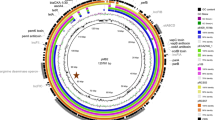Abstract
Resistance to arsenic salts in aPseudomonas aeruginosa clinical isolate was shown to be determined by a 100 kb transferable plasmid. The resistance pattern included arsenate, arsenite, and antimonate ions. Arsenate and arsenite resistances were inducible by previous exposure of cultures to subinhibitory amounts of either of the two ions. Phosphate ions protectedP. aeruginosa cells from the toxic effects of arsenate but did not alter arsenite toxicity.
Similar content being viewed by others
References
Casse F, Boucher C, Julliot JS, Michel M & Denarie J (1979) Identification and characterization of large plasmids inRhizobium meliloti using agarose gel electrophoresis. J. Gen. Microbiol. 113: 229–242
Cervantes-Vega C, Chávez J, Córdova NA, de laMora P & Velasco JA (1986) Resistance to metals byPseudomonas aeruginosa clinical isolates. Microbios 48: 159–163
Chen CM, Misra TK, Silver S & Rosen BP (1986) Nucleotide sequence of the structural genes for an anion pump. The plasmid-encoded arsenical resistance operon. J. Biol. Chem. 261: 15030–15038
Chen CM, Mobley HLT & Rosen BP (1985) Separate resistances to arsenate and arsenite (antimonate) encoded by the arsenical resistance operon of R factor R773. J. Bacteriol. 161: 758–763
Efstathiou JD & McKay LL (1977) Inorganic salts resistance associated with a lactose-fermenting plasmid inStreptococcus lactis. J. Bacteriol. 130: 257–265
Gotz F, Zabielski F, Philipson L & Lindberg M (1983) DNA-homology between the arsenate resistance plasmid pSX267 fromStaphylococcus xylosus and the penicillinase plasmid pI258 fromStaphylococcus aureus. Plasmid 9: 126–127
Hedges WR & Baumberg S (1973) Resistance to arsenic compounds conferred by a plasmid transmissible between strains ofEscherichia coli. J. Bacteriol. 115: 459–460
Holloway BW (1965) Variations in restriction and modification following increase in growth temperature inPseudomonas aeruginosa. Virology 25: 634–642
Meyers JA, Sanchez D, Elwell LP & Falkow S (1976) Simple agarose gel electrophoretic method for the identification and characterization of plasmid deoxyribonucleic acid. J. Bacteriol. 127: 1529–1537
Misra TK, Nucifora G, Chu L & Silver S (1989) Plasmid-determined heavy metal resistances: arsenic, cadmium and mercury. In: Hamer DH & Winge DR (Eds) Metal Ion Homeostasis: Molecular Biology and Chemistry (pp 417–426). Alan R. Liss, New York
Mobley HLT & Rosen BP (1982) Energetics of plasmid-mediated arsenate resistance inEscherichia coli. Proc. Natl. Acad. Sci. USA 79: 6119–6122
Nakahara H, Ishikawa T, Sarai Y & Kondo I (1977) Frequency of heavy-metal resistance in bacteria from inpatients in Japan. Nature 266: 165–167
Novick RP & Roth C (1968) Plasmid-linked resistance to inorganic salts inStaphylococcus aureus. J. Bacteriol. 95: 1335–1342
Rosen BP & Borbolla MG (1984) A plasmid-encoded arsenite pump produces arsenite resistance inEscherichia coli. Biochem. Biophys. Res. Commun. 124: 760–765
Rosen BP, Weigel U, Karkaria C & Gangola P (1988) Molecular characterization of an anion pump. The ArsA gene product is an arsenite (antimonate)-stimulated ATPase. J. Biol. Chem. 263: 3067–3070
Silver S (1978) Transport of cations and anions. In: Rosen BP (Ed) Bacterial Transport (pp 221–234). Marcel Dekker, New York
Silver S, Budd K, Leahy KM, Shaw WV, Hammond D, Novick RP, Willsky GR, Malamy ML & Rosenberg H (1981) Inducible plasmid-determined resistance to arsenate, arsenite, and antimony (III) inEscherichia coli andStaphylococcus aureus. J. Bacteriol. 146: 983–996
Silver S & Keach D (1982) Energy-dependent arsenate efflux: the mechanism of plasmid-mediated resistance. Proc. Natl. Acad. Sci. USA 79: 6114–6118
Silver S & Misra TK (1988) Plasmid-mediated heavy metal resistances. Annu. Rev. Microbiol. 42: 717–743
Silver S & Nakahara H (1983) Bacterial resistance to arsenic compounds. In: Lederer WH & Fernsterheim RJ (Eds) Arsenic: Industrial, Biomedical and Environmental Perspectives (pp 190–199). Van Nostrand Rheinhold, New York
Silver S, Nucifora G, Chu L & Misra TK (1989) Bacterial resistance ATPases: primary pumps for exporting toxic cations and anions. Trends Biochem. Sci. 14: 76–80
Smith HW (1978) Arsenic resistance in Enterobacteria: its transmission by conjugation and by phage. J. Gen. Microbiol. 109: 49–56
Summers AO, Jacoby GA, Swartz MN, McHugh G & Sutton L (1978) Metal cation and oxyanion resistances in plasmids of Gram negative bacteria. In: Schlessinger D (Ed) Microbiology-1978 (pp 128–131). American Society for Microbiology, Washington, DC
Tisa LS & Rosen BP (1990) Molecular characterization of an anion pump. The ArsB protein is the membrane anchor for the ArsA protein. J. Biol. Chem. 265: 190–194
Willsky GR & Malamy MH (1980) Effect of arsenate on inorganic phosphate transport inEscherichia coli. J. Bacteriol. 144: 366–374
Author information
Authors and Affiliations
Rights and permissions
About this article
Cite this article
Cervantes, C., Chávez, J. Plasmid-determined resistance to arsenic and antimony inPseudomonas aeruginosa . Antonie van Leeuwenhoek 61, 333–337 (1992). https://doi.org/10.1007/BF00713941
Received:
Accepted:
Issue Date:
DOI: https://doi.org/10.1007/BF00713941




